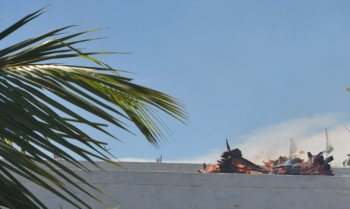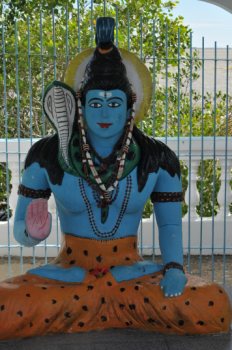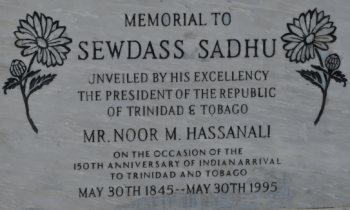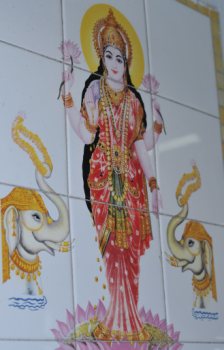Sadhu

|
The remarkable story of The Temple
in the Sea.
We stopped a short way from the Pitch Lake for lunch. Bear had goat roti, me a chicken roti. The package came, looked benign and Bear tucked in. BUT on top of the two doubles he had had mid morning, I was in for a VERY rough night. With the gaseous exchanges the boat rocked in her cradle and even the dogs started to howl as if they sensed an earth quake, not just a man passing wind. He leapt up at four and had to rush to the toilet. I rang Jessie the next morning and warned him never to let Bear near any curried chick peas again or I would sue him. Giggling he hung up. I'm still serious. Back to our tour and off we went.
As not to intrude we sat in the van while Jessie explained all about Hindu cremations. En route to our next stop we passed a major cremation site outside San Fernando, four were in progress when we arrived. They look very similar to any other except that the funeral pyre is in the open. Afterward many ashes are cast onto the waters, some are interred in a burial plot much the same as Christians would.
Next stop was a wonderful 'side of the road' fruit and vegetable stall, we all got out and bought bags full of super fresh produce.
Then we arrived at The Temple on the Sea. The Waterloo Cremation Site is next to the grounds behind the gazebo are three places for pyres. A statue of Shiva on the way to the Temple. Since the middle of the 19th Century when slavery was abolished people from the Indian subcontinent came over to become indentured workmen to tend the sugar cane plantations. At the end of six years they were offered a free passage back to their homeland or given a piece of land to call their own, on one condition, they were Catholic. Most stayed and now 42% of the population here in Trinidad is Indian. Presbyterian churches are also called ‘Indian Churches’ in Trinidad. Many are Hindu. Well over two hundred Hindu mandir, over 100 Muslim masjid, and a Sikh gurudwara can be found there today. During the colonial period Hindus in Trinidad needed to own the land where they wanted to build their mandir, otherwise it might be disrespected or destroyed. Even when they had permission from a plantation owner to build their places of worship, this permission could always be revoked. A devout Hindu gentleman in Trinidad named Sewdass Sadhu, an indentured labourer who came to Trinidad in 1907, built a siwala near the sea just after WWII ended but he did not own the land. Representatives of the landowners, Tate & Lyle destroyed the temple. Sewdass Sadhu built it again, again it was destroyed. Sadhu built the temple for a third time, the new landowners, Caroni Ltd., destroyed the temple and took Sewdass to court and had him fined £100 or 14 days in prison. But he would not be dissuaded. With great devotion and much effort Sadhu declared if he couldn't build on the land he would just have to build in the sea, Sadhu carried rocks and soil in two buckets and an old lady's bicycle during low tide to build up a pathway and foundation for his temple in the sea - a place that was beyond the reach of the landowners. Thousands of buckets later the temple could be built. In 1970, Sewdass Sadhu died and without a dedicated caregiver, the mandir declined. The tide broke down the surrounding wall and the shrine to the right deteriorated with storms. The murtis were removed, but it was clear that devotees still came to perform puja here. In the 1990's a renewal of the temple began with the support of local citizens and government funding. In 1995 a new temple was created on this site, and a memorial to Sewdass Sadhu was inaugurated for the celebration of Indian Arrival Day.
Sewdass Sadhu is now a
national hero. His faith and dedication has inspired thousands of people who
come here on pilgrimage to honour the deities and their most fervent
devotee.
If Sadhu was with us today, he would understand the pain
that devotees suffered in August of 2007 when vandals cast several of the
temple’s murtis into the sea and desecrated this sacred place. Unlike Sadhu’s
time, Trinidadians of all faiths were horrified at this desecration and
supported the Hindu community, the temple is now restored. Sewdass Sadhu
believed in the power of Mahadev and his own faith to overcome adversity.
spiritual strength of Sadhu and all
devotees.

A well known site of worship for Hindus as
well as a tourist attraction, the temple is a lovely
place to come and visit. Five hundred feet into the quiet waters of the
Gulf of Paria, it today continues to stand on the very spot Sadhu first built
it. The temple was once described as the first of its kind in the western world
by Dharmacharya Pundit Krishna Maharaj. With two buckets and an old lady’s
bicycle with a carrier at the back, it is amazing that anyone could achieve such
a feat.
 Even this dog was
completely at peace here at this quiet Holy site
 
 The flowers were
beautiful even one of the thrown murtis seemed
at peace
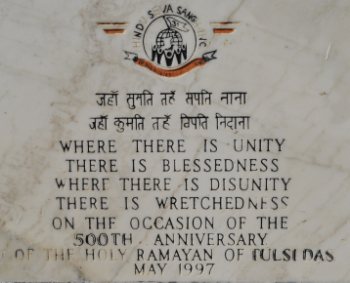 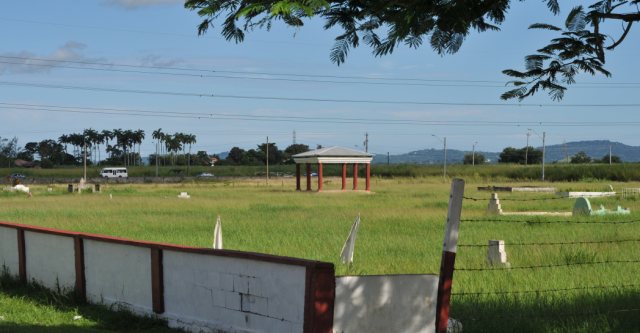 The Hindu burial ground
is behind the wall, beyond the fence is an unmarked field which is the
Muslim burial ground.
 Would not have missed
coming here.
ALL IN ALL JUST GOES TO SHOW
WHAT ONE MAN AND DEVOTION CAN ACHIEVE
|




